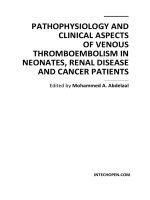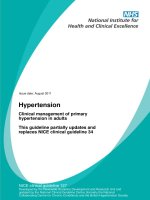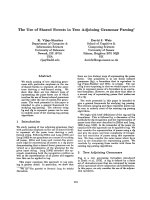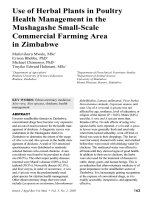CLINICAL USE OF PLATELET-RICH PLASMA IN ORTHOPAEDICS
Bạn đang xem bản rút gọn của tài liệu. Xem và tải ngay bản đầy đủ của tài liệu tại đây (836.5 KB, 11 trang )
CLINICAL USE OF PLATELET-RICH PLASMA IN ORTHOPAEDICS
- PRP (1970)
- Recent technologic advances : the hospital
outpatient and ambulatory surgical centers…even
into physicians’ offices.
The following growth factors can be found in the
environment of a blood clot:
- Transforming growth factor beta (TGF-b)
- Platelet-derived growth factor (PDGF)
- Insulin-like growth factor (IGF)
- Vascular endothelial growth factors (VEGF)
- Epidermal growth factor (EGF)
- Fibroblast growth factor-2 (FGF-2)
-
The repair response:
The formation of a blood clot and degranulation of platelets, growth factors and cytokines
( microenvironment) : chemotaxis of inflammatory cells + the activation and proliferation of local progenitor
cells fibroblastic scar tissue : a fracture callus, these conditions can also facilitate the formation of new
bone tissue.
Many of these factors :
+ osteogenesis ( PDGF, EGF, and FGF-2 : stimulate proliferation of osteoblastic progenitors )(TGF-b increases
matrix synthesis (eg, type I collagen) in vitro and in vivo.
+ Angiogenic factors (VEGF and FGF-2 : angiogenesis and revascularization )
- Enriching a rich environment:
+The result is an autologous PRP that contains a biologically active mixture of growth factors without the
potential for an immune response.
+The effect of the clot microenvironment or concentrates of PDFGs on fracture repair
+ Clots also contain bone morphogenetic proteins (BMPs).
+The growth factors associated with PRP also promote fibroblastic growth, differentiation, and scar
formation.
The most common applications include:
- Tennis elbow (lateral epicondylitis);
- Achilles tendonitis (inflammation and swelling of the Achilles tendon);
- Patellar tendonitis (inflammation of the patellar tendon, also called "Jumper's Knee");
- Rotator cuff tendonopathy….









